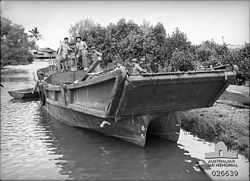Daihatsu-class landing craft
From Wikipedia, the free encyclopedia
 | |
| Class overview | |
|---|---|
| Name: | Daihatsu Class, Landing Craft |
| Operators: |
during World War II: |
| Planned: | 3,229 |
| General characteristics (Daihatsu-class landing craft) | |
| Type: | Landing Craft |
| Tonnage: | 21 tons |
| Length: | 47 ft (14.33 m)o/a |
| Beam: | 10 ft (3.05 m) |
| Draught: | 2.6 ft (0.79 m) |
| Installed power: | 60 hp |
| Propulsion: | Diesel |
| Speed: | 8 knots (14.8 km/h) |
| Range: |
|
| Capacity: | 1 Type 95 7.4 ton tank or 70 men or 10 tons cargo |
| Complement: | 12 |
| Armament: |
|
The Daihatsu-Class or 14m landing craft (大発, abbreviation of 大型発動機艇 which means "large motorized boat") was a type of landing craft, used by the Imperial Japanese Army during World War II. It was similar to the Landing Craft, Vehicle, Personnel (LCVP), with a bow ramp that was lowered to disembark cargo upon riding up onto the beach. The landing craft was more seaworthy than an LCVP due to its hull design. It was constructed of a metal hull and powered by a diesel engine.
The landing craft could be modified to carry weapons of up to 37mm caliber as armament and could be uparmoured against 40mm fire.

An example captured at the Battle of Milne Bay
References
- Jentschura, Hansgeorg; Jung, Dieter; and Mickel, Peter. Translated by Brown, J.D. 1977. Warships of the Imperial Japanese Navy, 1869-1945. Naval Institute Press. ISBN 0-87021-893-X.
- Morison, Samuel Eliot. 1950. History of United States Naval Operations in World War II, Volume VI: Breaking the Bismarck Barrier, 22 July 1942-1 May 1942. Boston: Little, Brown, and Company.
- Parillo, Mark P. 1993. The Japanese Merchant Marine in World War II. Naval Institute Press. ISBN 1-55750-677-9
This article is issued from Wikipedia. The text is available under the Creative Commons Attribution/Share Alike; additional terms may apply for the media files.